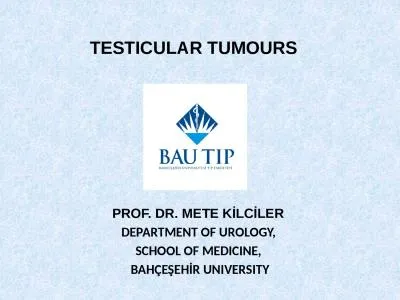

DEPARTMENT OF UROLOGY SCHOOL OF MEDICINE BAHÇEŞEHİR UNIVERSITY Tumo u rs of the testis Introduction I ntratesticular malignant 9095 germ cell tumors 12 Bilateral ID: 914102
Download Presentation The PPT/PDF document "TESTICULAR TUMOURS PROF. DR. METE KİLC�..." is the property of its rightful owner. Permission is granted to download and print the materials on this web site for personal, non-commercial use only, and to display it on your personal computer provided you do not modify the materials and that you retain all copyright notices contained in the materials. By downloading content from our website, you accept the terms of this agreement.
Slide1
TESTICULAR TUMOURS
PROF. DR. METE KİLCİLER DEPARTMENT OF UROLOGY, SCHOOL OF MEDICINE, BAHÇEŞEHİR UNIVERSITY
Slide2Tumo
u
rs
of the testis
Introduction:
I
ntratesticular
-
malignant
90-95
% germ cell tumors
1-2% Bilateral
-
lymphoma
7-10
% of
testis
tumors
develop in cryptorchidism
Orchiopexy
does not alter the malignant potential
Exogenous estrogen
t
o
the mother during pregnancy
Survival of patients has improved dramatically
Slide3Tumo
u
rs
of the testis
Classification:
Primary
Benign
Secondary
Malignant
Germ cell
Non germ cell
Germ cell tumors:
Seminoma
Non
-
seminomatous
: Embryonal
Teratoma
Choriocarcimoma
Mixed tumors
Slide4Primary Testicular Cancer
GERM CELLSeminoma 35%Classic (85%)Anaplastic (5-10%)Spermatocytic
(5-10%)
Embryonal 4%Adult typeInfantile type (yolk sac tumor)Teratoma 10%Choriocarcinoma 1%Mixed cell type 40%TeratocarcinomaNONGERM CELLLeydig 1-3%
Sertoli
<1%
Gonadoblastoma
0.5%
Slide5Seminoma
Slide6Embriyonal carcinoma
Grossly, the tumors are large, often hemorrhagic and necrotic producing at cut surface.
Slide7Pathologic features of yolk sac tumor
Gross: The cut surface is gray-white and may be cystic.
Slide8Choriocarcinoma: large, hemorrhagic, necrotic tumor.
Slide9Tumors of the testis
Clinical findings
A-symptoms:
Painless
enlargment
of testis
Acute
testic
u
l
a
r
pain (10%)
Symptoms related to metastasis (10%): back pain-cough-dyspnea anorexia-nausea- bone pain- lower ext. edema
Asymptomatic (10%)
Slide10Tumors of the testis
Clinical findings
B: signs:
Testicular mass or diffuse
enlargment
Node palpation
Gynecomastia
Slide11Tumors of the testis
Laboratory findings and tumor markers:
Anemia-
increased
l
iver
function tests-
increased
creatinin
Tumor markers:
A
FP
Β
-
HCG
LDH
hCG(%)
AFP
(%)
Seminoma
Teratoma
Teratocarcinoma
Embryonal
choriocarcinoma
7
25
57
60
100
0
38
64
70
0
Slide12Alpha Feto
ProteinExpressed by the early embryo (also liver and GI tract)Half-life: 5-7 daysProduced by pure embryonal, teratocarcinoma
, yolk sac, mixed tumors (NOT pure
choriocarcinoma or seminoma)Falsely elevated in liver dysfunction, viral hepatitis
Slide13Beta Human
Chorionic GonadotrophinSecretory product of the placentaHalf-life: 24-36 hoursProduced by syncytiotrophoblastic tissueAll choriocarcinomas, 60
% embryonal,
10% seminomaFalsely elevated in hypogonadism and marijuana use
Slide14Presents normally in smooth, cardiac and skeletal muscle, liver and brainMost useful in advanced seminoma or tumors where other markers are not elevated
Many false positivesLactic Acid Dehydrogenase
Slide15Tumors of the testis
Imaging
Ultrasonography
CT-Scan
MR
Slide16Risk Factors
Cryptorchidism: 7-10% of patients with testicular cancer have a history of cryptorchidismAbnormal germ cell morphologyElevated temperature5-10% of patients with testicular cancer and a history of cryptorchidism develop cancer in the contralateral testisOrchidopexy does not prevent development of cancer
Slide17Gonadal Dysgenesis 20-30% develop cancer (gonadoblastoma
) Trauma HormonesEstrogen in the pregnencyAtrophy (nonspecific vs. mumps orchitis)Speculative
Risk Factors
II
Slide18Differential diagnosis
Epdidymitis & Epididymoorchitis
Hydrocele
Spermatocele
Hematocele
Granulomatous orchitis
Varicocele
Epidermoid cyst
Tumors of the testis
Slide19Radical Orchiectomy
Inguinal approach best way for the surgeryAvoid seeding the scrotum and disrupting lymphatics
Slide20Treatment
Inguinal Exploration & radical orchiectomy
Low stage seminoma: retroperitoneal irradiation
95% care
high stage seminoma: primary chemotherapy
95% complete response
Tumors of the testis
Slide21Treament
C: low stage NSGCT:
Radical
orchiectomy
1)
C
onfined
within tunica
albuginea
?
2)
V
ascular
invasion
?
3)tumor
markers? 4)radiographic imaging? Tumors of the testis
Slide22Treatment
of h
igh
stage NSGCT:
primary
chemotherapy
+RPLND
Tumors of the testis
Slide23Follow up:
every 3 month/ first 2 years
every 6 month/ until 5 years
and then yearly
C
areful
exam of remaining testis, abdomen, lymph node area
tumor marker at each visit.
CT
every 3-4 month
Tumors of the testis
Slide24Prognosis
Seminoma:
R.O+radiotherapy
:
stage I: 98% 5 years survival rate
stage II:
92%
5 years survival rate
stage III (chemotherapy): 35-75%
NSGCT: stage I: 96-100%
low, volume stage II: 90%
stage III: 55-80%
Tumors of the testis
Slide25Secondary tumors of the testis
1. lymphoma
: M
ost
common
t
estis
t
umour
in>50 years old
2.
leukemia
:
Testis b
iopsy
is choice
3. metastatic tumor:
prostate- lung –GI-melanoma-kidneyTumors of the testis
Slide26Extragonadal
germ cell tumors
3% of all germ cell tumors
the most common sites: mediastinum-
retroperitoneum
,
sacrococcygeal
–
pineal gland
Tumors of the testis
Slide27Tumors of the epididymis,
paratesticular
tissue & spermatic cord
T
umor
o
f
epididym
: commonly benign:
adenomatoid
leiomyoma
cystadenoma
T
umor
of spermatic cord:
lipoma
Rabdomyosarcoma
leiomyosarcoma
. Fibrosarcoma liposarcoma
Tumors of the testis
Slide28Sex cord-stromal tumors of the testis
Slide29Leydig cell tumor key facts:
Can develop at any age from infancy to old ageMost are benign, some are malignMost tumors are hormonally active, but some are inactiveMay secrete androgens or estrogens-Androgen excess: Premature puberty & macrogenitosomia
-Estrogen excess: Gynecomastia in adult males
Slide30Sertoli cell tumor
These tumors are more rare than Leydig cell tumors. They elaborate androgens or estrogens. Occasionally, they cause gynecomastia but sexual precocity is infrequent.
Slide31Thank
You